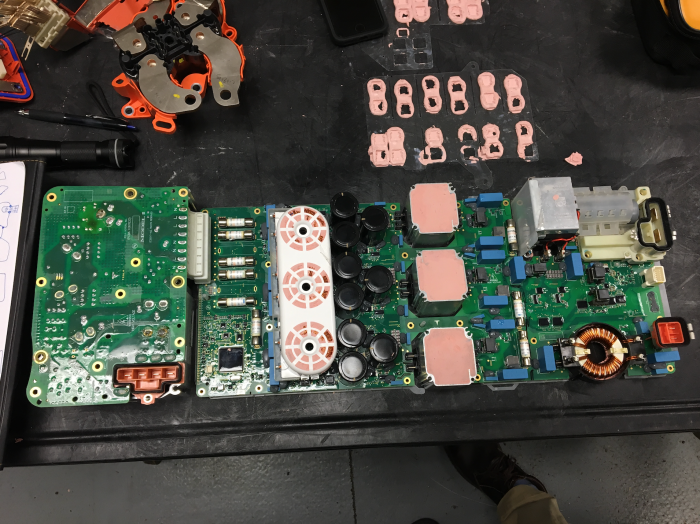
A typical single 120V outlet in a Ram pickup truck.
Tesla’s Cybertruck, set to be unveiled tonight, will push the boundaries on conventional pickup design. One likely innovation will be the number, type, and capability of its AC power outlets.
Large pickups from the big makers like Ford, GM, and Ram come with a single 120V outlet either located in the cab or in the bed near the tailgate.
This feature is often marketed as enabling use of power tools at construction sites but powering a laptop or two might be more realistic. These outlets are almost uniformly limited to 400 Watts of power or less. A single typical corded electric drill can require more than that. Forget about larger tools or plugging in a home refrigerator during an extended power outage.
A rare exception is the Mitsubishi Outlander which isn’t even a truck but is a plug-in hybrid SUV. It sports two 120V outlets rated for up to 1,500W which is essentially equivalent to a regular home 120V outlet circuit. If the Outlander’s 12 kWh battery runs low, the gas engine starts up intermittently to act as a generator.
But even a 1,500W 120V outlet can be limiting. What about cooking at a campsite with both an electric grill and an electric hot plate or two at the same time? That takes more than 1,500 Watts. “Cooking with gas” used to be positive catchphrase but we need to move away from fossil fuels.

The Bollinger pickup prototype has four 120V outlets in the rear bed.
Bollinger Motors, the EV outdoor adventure truck and SUV startup, has figured this out and plans to offer not just a single 120V outlet but 10. Four are located in the back and others are scattered in the cab and other areas. The outlets will be grouped into six switchable circuits so they can be de-powered when not in use. They are also considering support for a 240V outlet. They haven’t yet decided on what power capacity to support. But, like other vehicles with AC power outlets, Bollinger will be using a separate dedicated inverter to supply the AC.
Rivian, another but better EV funded startup, is also promoting the three AC outlets in their own R1T truck but haven’t said how much power they will be rated for. Rivian recently showed off an electric camping grill concept at this year’s Overland West festival in Arizona. The grill, which the company intends to sell as an accessory, uses up to 3 kW but separately taps into the high-voltage battery rather than sharing power with the AC outlets.

Rivian’s pull-out electric cooking grill concept which fits in the truck’s storage area between the cab and truck bed.
Tesla CEO Elon Musk seems to be setting high expectations.
While that was said over a year ago there is no reason to think anything has changed.
Tesla has hinted that pricing on the new truck could be targeting the $50,000 price point which would be a challenge with a large truck with a substantial battery pack. What if Tesla could provide over 10,000 Watts of 120 and 240V power at multiple outlets at minimal added cost?
Marco Gaxiola thinks they can. He’s an engineer at GM’s Cruise Automation subsidiary that’s developing a fully automated driving system using Chevrolet Bolt EVs on the streets of San Francisco.
But prior to joining Cruise he worked at another company that did one of the early teardowns of a Tesla Model 3. As part of that effort, Gaxiola had access to the circuit boards taken from the Model 3’s Power Conversion System otherwise known as it’s built-in AC battery charger. Gaxiola believes this charger design is capable, from a latent hardware perspective, of operating bidirectionally even though it isn’t used that way today in the Model 3.

The Tesla Model 3 Power Conversion System.
Usually, AC battery chargers take incoming AC power from a J1772 plug or Tesla’s equivalent connector and convert it into DC power at the appropriate voltage needed to add energy to the vehicle’s battery pack. A bidirectional charger would be capable of taking DC power back out of the battery and converting it into AC power.
Various designs for bidirectional AC battery chargers have been developed over the years but they haven’t been used in commercial mainstream EVs. One reason is that there haven’t been so-called V2G (Vehicle to Grid) standards for J1772 to define how that AC can be exported back out into the J1772 cable. Using bidirectional capability to power built-in AC outlets in a vehicle doesn’t require J1772 standards and, in any case, Tesla has been willing to innovate when charging standards aren’t available.
The advantage of re-using the battery charger to supply AC power is that its already paid for and already supports, in the case of the Model 3, up to 48A or 11 kW of power. It could make a lot of sense for Tesla to re-use the Model 3’s battery charger in the Cybertruck and update the controller software to allow bidirectional use.
Categories: General
It’s not a matter of software, to provide AC power, and ideally pure sine wave. AC charger modules only rectify AC power into DC and then boost/buck it as needed and limit the output current. Tesla needs to add an inverter, probably at least two for 120V and 240V. They knows how to make good inverters, so it has been a bit disappointing that the Models S/X/3 do not have AC power outputs.
LikeLike
It is possible to design battery charger hardware that is capable of operating bidirectionally (operating as either a rectifier during charging or as an inverter while discharging the battery) to provide AC power (V2G). You can find university dissertations and project reports online describing bidirectional EV battery charger design.
The article speculates that Tesla could use a bidirectional charger in the Cybertruck to minimize costs while providing high power output to multiple AC power outlets. The article quotes an engineer who has made a close analysis of the Model 3 battery charger as saying that it may already have the capability to be used bidirectionally although the cars software today does not utilize that possible latent hardware ability.
LikeLike
Tesla has not been a proponent of V2G and it is unlikely that they have integrated a grid-tie inverter to do that via an AC EVSE and increase cost and complexity without using it.
The drive inverters are already “bidirectional” as it comes for free, the drive transistor flyback diodes rectify and send power back to charge the battery during regen. However only the first gen. Renault Zoe used the drive inverters for charging from the grid, most EVs have dedicated onboard AC chargers optimized for that. Even if there is a grid-tie inverter, one would want a dedicated accessories inverter to reduce complexity of having an interlocking junction box and to allow the EV to both charge from a DC/AC source and drive while powering the AC accessories.
It’s more than just software 🙂
LikeLike
The article does not suggest that the Cybertruck AC output would be literally used/supported for grid-tie just for output via 120/240 outlets on the truck.
You write: “to allow the EV to both charge from a DC/AC source and drive while powering the AC accessories”.
I doubt Tesla would need to support the “use case” of charging the truck battery while driving the truck at the same time. That’s not possible with any other EV. Are you really suggesting that or did I misunderstand what you wrote?
Nor would Tesla need to necessarily support providing power to the truck’s AC outlets while AC charging the truck battery (while stopped).
In any case, while Tesla confirmed the truck will have high power AC outlet capability they have not yet given detailed specs or said if they will use separate inverters. Time will tell.
LikeLiked by 1 person
Charging the truck while using the AC outlets on it. Say you have a mini fridge plugged it, do you want it turning off while driving or charging?
LikeLike
Why would it turn off during driving? The only issue is turning off during AC charging. That’s a limitation. If Tesla does go with the a bidirectional battery charger solution perhaps they can put in one 120V outlet with low power output (400W) that uses a separate inverter and leave the others and high power 240 outlet for the battery charger.
LikeLike
Three days ago Jack Rickard of EVTV endorsed the exact same idea of using a Model 3 derived battery charger in bidirectional mode to provide the power to the Cybertruck’s AC power outlets.
Check out his views beginning at the 15 minute mark of this (unfortunately titled) video:
LikeLike
I believe the optional 1,500W inverter on the Outlander PHEV GT trim runs off the high voltage traction battery, not the 12V system.
LikeLiked by 1 person
Seems sensible but I don’t know how they actually implemented it.
LikeLike
Tesla will do it better than anyone. 120 and 240 with higher power will really be a game changer for contractors. As a back up for you home it would be great too.
LikeLiked by 1 person
“Tesla has hinted that pricing on the new truck could be targeting the $50,000 price point”
🧐
^ Probably be good to update this number. (The Cybertruck pricing is very well known. Listed on the website, pre-orders page, and announced on stage). The Cybertruck will be available starting at $39K, fairly sure.)
LikeLike
“Tesla has hinted that pricing on the new truck could be targeting the $50,000 price point”
🧐
^ Probably be good to update this number. (The Cybertruck pricing is very well known. Listed on the website, pre-orders page, and announced on stage). The Cybertruck will be available starting at $39K, fairly sure.)
LikeLike
Assuming there is a 240v outlet, can I plug it into my generator’s MTS to backfeed home circuits? If they enable bidirectional charging via the HPWC, should I put that 60A breaker in the generation panel used for my PW/solar or elsewhere? My hope is the 30 or 40a from my CT can add to the 30a from my PW to cover even my largest loads. If not I will need another overpriced PW and will get a Y instead.
LikeLike
I’m not an electrician so I couldn’t tell you the details about hooking the vehicle up to a home wiring system.
While Tesla has now confirmed the general features of the CyberTruck AC power output ability I’m not aware of them committing to detailed specifications on voltage and amperage of output. The CT has been delayed a bit, likely in part due to delays with the new 4860 battery cell production, so we may not get better CT specifications for another year or two.
LikeLike
Just to clarify. the battery is the 4680 cell.
LikeLiked by 1 person
Sigh. Typo. You are correct. It is 4680. I knew that. I even double checked to verify my memory before writing it. And then I typed it wrong….
Thanks for pointing it out!
LikeLike
Help!
LikeLike